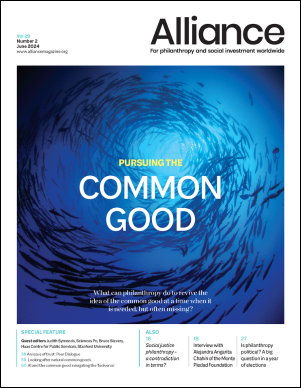Why philanthropic giving is a smart investment tool for business.
Socially conscious investors are after more than just financial returns. In addition to making money in the markets, we also want to make a difference. We want to leave a legacy of not just wealth but positive change. However, in our quest to be socially conscious change creators, we often overlook the power of one key asset: our philanthropy.
For most people, philanthropy is the money we give away when we’re finished investing and earning in other areas. It’s a separate category — not just on our tax returns or financial planning documents, but also in our heads. The idea that one makes money first, then gives it away is about as American as apple pie.
But smart investors realize that philanthropy is much more than charity. Philanthropy is an investment tool that can transform outcomes for ourselves and for the world.
Here’s an example: Suppose you have a passion for food and nutrition, and you want to see a world in which everyone understood and ate in a healthier, more sustainable way. You open a farm-to-table restaurant that grows into a regional chain. Your investment in this business pays off handsomely, and you look forward to continued growth. To do that, you’ll need to ensure a steady source of farm-fresh ingredients for all your restaurants. At the same time, you want to carry the message of healthy, sustainable food beyond your company walls. So you begin to make philanthropic investments in nonprofit organizations that help new and existing small farmers understand and deploy sustainable practices. Or perhaps you invest in nonprofit co-ops that help the farmers you depend on strengthen their own businesses while expanding knowledge about healthy, sustainable food far beyond your restaurant. And as an added bonus, that new knowledge results in more customers for your business.
As your business continues to grow and the nonprofits in which you make philanthropic investments also thrive, you might take it a step further. You could, for example, advocate for more supportive policies for small farmers or invest in other organizations that promote healthy eating on a broader scale.
Could your restaurant business deliver returns without the philanthropic investment? Probably, at least in the shorter term. But you might eventually have difficulty sourcing the sustainably produced ingredients you need if small farmers aren’t thriving. And you definitely wouldn’t be achieving the scale of positive change you sought.
Including philanthropic investments within an entire investment portfolio is what my friend and colleague Jed Emerson calls ‘investing for total return.’ He’s recently released a book on that subject, titled The ImpactAssets Handbook for Investors, and I was honored to author the chapter Transformational Giving: Philanthropy as an Investment in Change.
One key to achieving total return is to think beyond the traditional market investments that are available and determine where mutually beneficial opportunities lie in the philanthropic arena. The restaurant example above could just as easily apply to an energy investor who wants to increase the presence of wind and solar power in the marketplace. Her portfolio might also include investments in nonprofits that support alternative energy start-ups. A fashion designer with a passion for women’s issues might make a philanthropic investment in nonprofits that help train women entrepreneurs, some of whom might supply materials for future clothing lines. And a manufacturer with a passion for reforming the juvenile justice system might make philanthropic investments in nonprofits that help youth identify and follow paths into manufacturing-related careers — thus helping to ensure his own future qualified workforce.
As a rule, the return on philanthropic investment isn’t quantifiable in the same way as market returns. Our society doesn’t have a system for placing a dollar value on a life changed for the better. Perhaps that’s why philanthropy is so often forgotten as a part of one’s overall investment strategy.
But we can see the positive impacts of philanthropic investments every day and easily draw connections between the philanthropic investments we make and the benefit that we — and the world around us — derive from them.
Could your investment strategy benefit from the addition of a philanthropic strategy? I’m betting the answer is a solid ‘yes.’ So, as you think about your investments — in your own business, in the stock market or in other areas — ask yourself, ‘What am I forgetting?’
Kris Putnam Walkerly is a global philanthropy advisor and founder of Putnam Consulting Group






Comments (0)